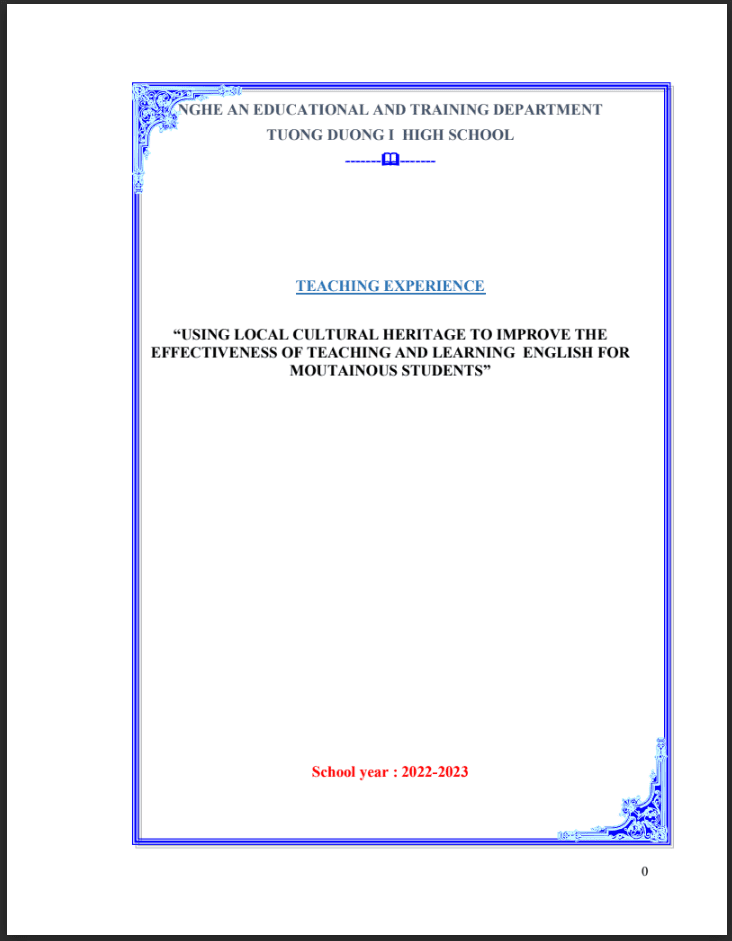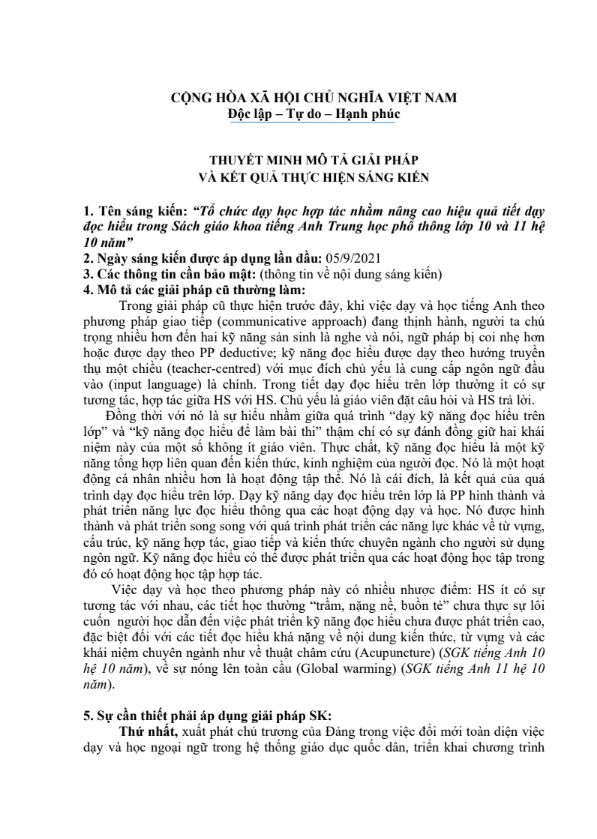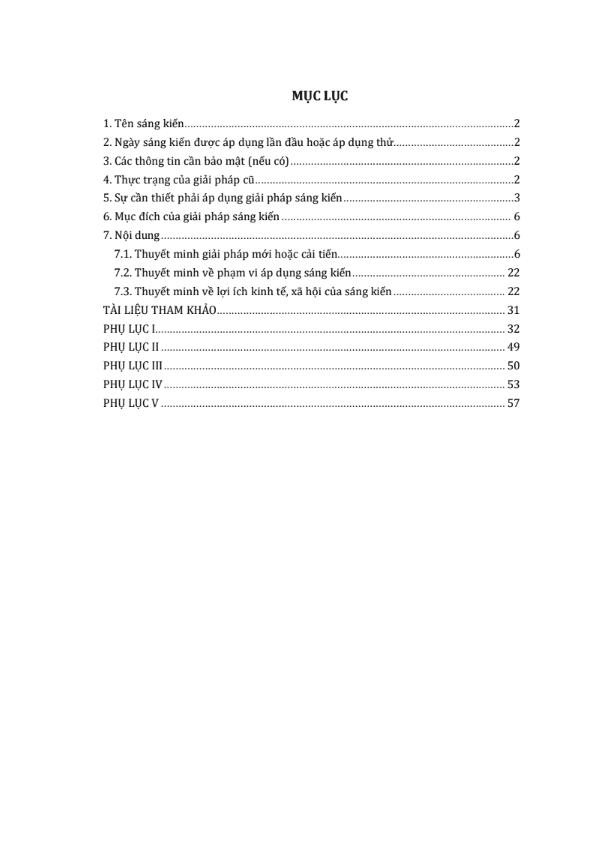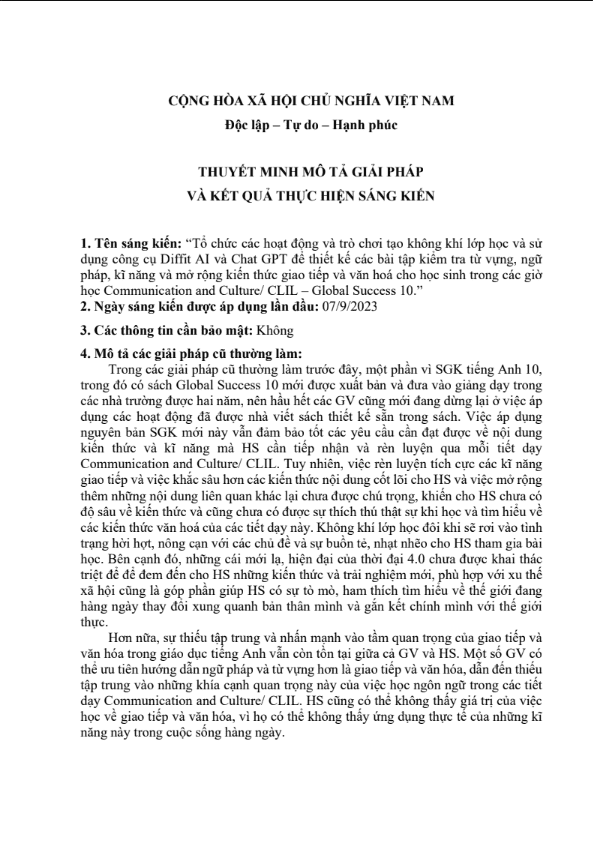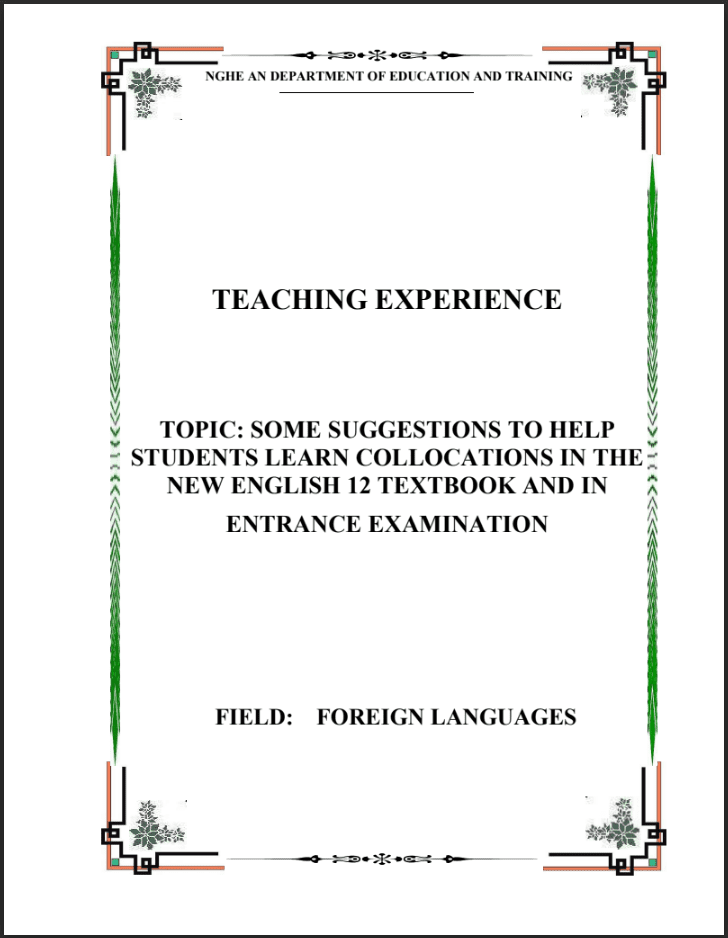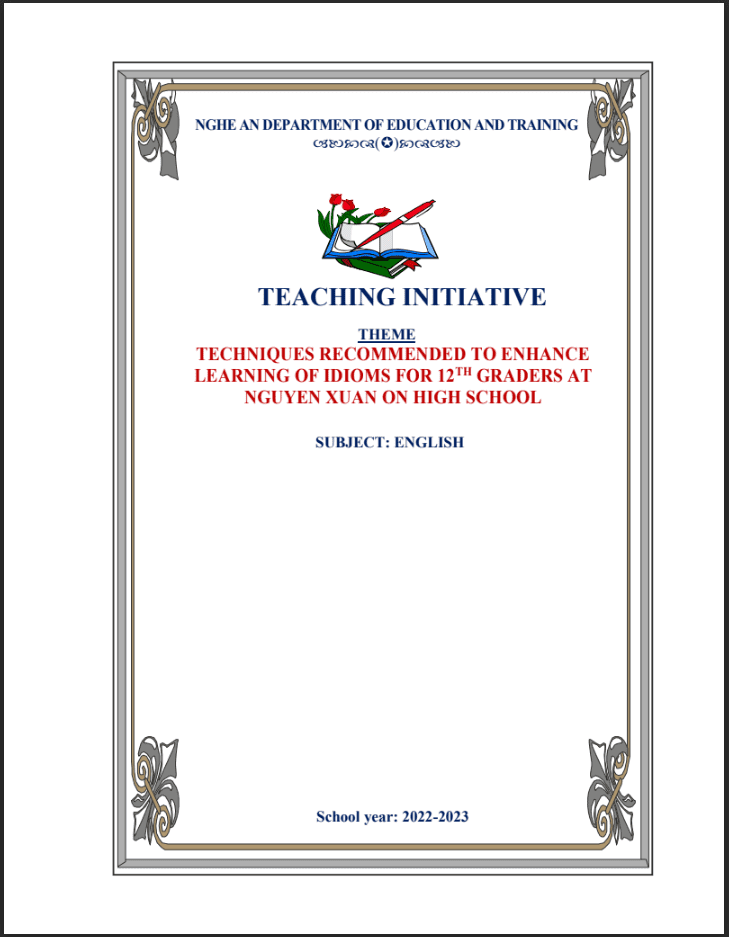SKKN Using local cultural heritage to improve the effectiveness of teaching and learning English for mountainous students
- Mã tài liệu: MP0101 Copy
| Môn: | Tiếng Anh |
| Lớp: | 10 |
| Bộ sách: | |
| Lượt xem: | 581 |
| Lượt tải: | 9 |
| Số trang: | |
| Tác giả: | Lê Thị Thu Huyền |
| Trình độ chuyên môn: | Thạc sĩ giáo dục |
| Đơn vị công tác: | THPT Tương Dương 1 |
| Năm viết: | 2022-2023 |
| Số trang: | |
| Tác giả: | Lê Thị Thu Huyền |
| Trình độ chuyên môn: | Thạc sĩ giáo dục |
| Đơn vị công tác: | THPT Tương Dương 1 |
| Năm viết: | 2022-2023 |
Sáng kiến kinh nghiệm “Using local cultural heritage to improve the effectiveness of teaching and learning English for mountainous students”triển khai gồm các biện pháp nổi bật sau:
Mô tả sản phẩm
- INTRODUCTION
- 1. Rationale of the study
Nowadays, language teaching concentrates on what students want to learn
rather than on what is to be taught. It can be said that the attitude and the initiative
from the students are the main activity in the classroom. The success of students in
the classroom is the main goal of teaching and learning activity. Many factors
influence students in the classroom. One of them is culture. It is important to relate
language to the culture because language must be treated in a social context. It
means that learning a language cannot be separated from learning the culture.
Resolution No. 29-NQ/TW requires a strong innovation in teaching and
learning methods in a modern direction, promotes the positivity, initiative,
creativity and application of learners’ knowledge and skills; overcoming one-sided
imposed communication. Moving from studying mainly in the classroom to
organizing diverse forms of learning, paying attention to social activities,
extracurricular experiences, and scientific research.
As an English teacher, I think that contributing to the comprehensive
renovation of education, towards achieving the aforementioned goals, the use of
local cultural heritage in teaching in high schools, is extremely important. Through
learning English and getting to know about different cultures, students can
understand and love the language and culture of their people better. Thus, the use
of local culture heritages in teaching in the classroom, especially learning at the
heritage site, not only helps students develop their foreign language skills, improve
their speaking and writing skills but also has an understanding of the local cultural.
As a result, raising awareness of heritages preservation and patriotism
among students could make a contribution to the development of the homeland.
Such are attractive extracurricular activities for high school students when
experiencing local culture sites. Aim of these activities is encouraging students to
learn more about historical sites, traditional costumes, and indigenous cuisines. By
these, students could apply experienced lessons into practical life and this is
considered as a way which encourages students to efficiently exposure to local
culture and history.
Tuong Duong 1 high school is located in a mountainous district being to the
southwest of Nghe An province. There is no doubt that teaching and learning
English is difficult because the students are mainly ethnic minority. Therefore, I
believe that combination of experiential activities with teaching projects in
teaching English is essential. Such learning activities will help students actively
and proactively acquire new knowledge, improve their self-study skill, understand
and apply the knowledge learned from practice to preserve local cultural heritage,
gain the patriotism, and promote positive values of local culture.
In order to help students to deeply recognize, and have the right attitude and
behavior to the issues of preserving the local cultural identity where they live, as
well as learning to accumulate knowledge and improve the quality of English
3
teaching in the context of reforming the country’s education, I choose the thesis
Using local cultural heritage to improve the effectiveness of teaching and
learning English for mountainous students”.
“
2
. Aims of the study
–
By including local culture in the teaching and learning process, it is
expected that students will be aware of their own culture and able to learn English
better since they are asked to describe something they know very well.
–
Educating students to love their hometown and country. In addition,
students have senses of protecting, promoting local culture to the domestic and
international community.
–
From the results of students’ learning, teacher can assess the abilities and
qualities of students.
3
. Scope of the study
The study is concerned about investigating the Local Culture values in
–
Tuong Duong district and the effectiveness of using them in teaching and learning
English.
–
The study was going to be conducted at Tuong Duong 1 high school, and
class 10C1, 10C2, 10A1 were asked to participate in the study.
. Methods of the study
4
In order to achieve the above- mentioned aim and objectives, the answers to
the research questions that are presented below should be found:
1
. How does local cultural heritage helps the mountainous students improve
their English learning?
2
. What are teachers and students’ suggestions for using local cultural
heritage to improve students’ English learning?
5
. Significance of the study
*
Theoretical aspect: It is hopefully expected that this study would make a
little contribution to help teachers and students realize the essential role of using
local cultural heritage in English language teaching.
*
Practical aspect: with the results of the study, it is hoped that teachers and
students would make some improvements in the English teaching and learning
method. The research finding indicated that bringing local culture in English
language teaching would build up learner’s cultural knowledge, awareness, and
competence.
4
- RESEARCH CONTENT
PART 1: THEORETICAL AND PRACTICAL BACGROUND
1
1
. Theoretical background
.1. Basic concepts of culture heritage
According to the open encyclopedia Wikipedia: Cultural heritage is the
heritage of physical artifacts and intangible attributes of a group or society
inherited from previous generations, maintained to the present and for generations
to come. Cultural heritage includes cultural property (such as buildings,
landscapes, monuments, books, works of art, and artifacts), intangible culture (such
as folklore, traditions, languages, and knowledge), and natural heritage (including
culturally important landscapes and biodiversity). Cultural heritage can be defined
as the legacy of physical artifacts (cultural property) and intangible attributes of a
group or society inherited from the past. Cultural Heritage is a concept which
offers a bridge between the past and the future with the application of particular
approaches in the present. Due to its attached values for these groups or societies,
cultural heritage is maintained in the present and bestowed for the benefit of future
generations.
+
Characteristics of Vietnam’s cultural heritage
Vietnam’s cultural heritage is the values crystallizing from the cultural
creativity of the community of 54 ethnic groups, undergoing a long historical
process, being transmitted, inherited and recreated from many generations to the
present day. Vietnam’s cultural heritage is a culturally diverse alandscape, a
valuable asset of the Vietnamese ethnic community and a part of humanity’s
cultural heritage. Vietnam’s cultural heritage plays a great role in building and
keeping nation of our people.
Vietnamese cultural heritage is the creative value of learning, exchanging
and inheriting from the cultures and human civilization. These values are a smooth
combination of the culture and culture of humanity with the long-standing
indigenous culture of the Vietnamese people.
Vietnamese cultural heritage, especially intangible cultural heritage, has a
strong vitality, which is being preserved and promoted in the life of the
Vietnamese ethnic community.
+
Heritage classification
Cultural heritage is divided into two categories: tangible cultural heritage
and intangible cultural heritage.
Tangible cultural heritage refers to physical artifacts produced, maintained,
and transmitted intergenerationally in a society. All these heritage sites and
monuments are here thanks to human creativity and have a global cultural
significance. It is important to preserve these cultural sites because of their value to
TÀI LIỆU LIÊN QUAN
- 7
- 105
- 1
- [product_views]
- 5
- 173
- 2
- [product_views]
- 4
- 165
- 3
- [product_views]
- 4
- 129
- 4
- [product_views]
100.000 ₫
- 6
- 434
- 5
- [product_views]
100.000 ₫
- 2
- 507
- 6
- [product_views]
100.000 ₫
- 9
- 546
- 7
- [product_views]
100.000 ₫
- 4
- 409
- 8
- [product_views]
100.000 ₫
- 2
- 595
- 9
- [product_views]
100.000 ₫
- 0
- 538
- 10
- [product_views]

